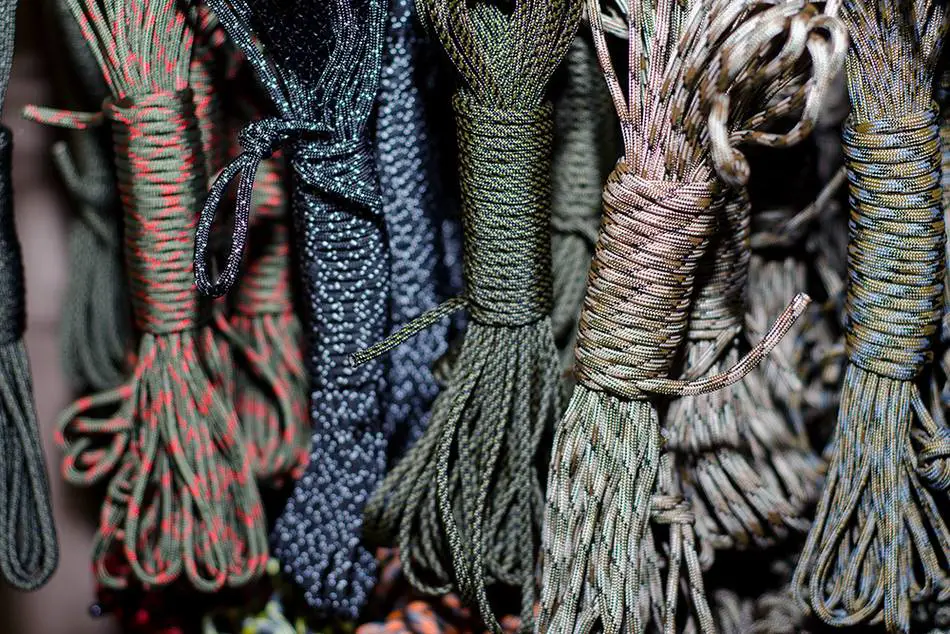The paracord is small, extremely strong, lightweight and can be used for different purposes, especially during emergency and lifesaving situations. So, why is the paracord used for survival, you ask? Here are just some of the paracord’s uses during survival situations:
- Start a fire
- Keep away bears
- Build a shelter
- Use it as a ladder
- Use it as a rescue line
- Use it to carry and transport big and heavy stuff
- Use it to catch fish
- Making a trap
- Use it as a tourniquet
- Use it to make a splint
This is, of course, just a short answer which I will elaborate later in the article. There are a lot more uses for the paracord, including during many emergency situations. I will mention a few of them, explain in details how the paracord can be applied in them, and even recommend some of the best paracords you can get. I will also explain the different uses of a survival bracelet, and recommend a few of bracelets as well. Let’s begin.
This article is also partially summarized in our video:
Table of Contents
- What is a Paracord
- What Are the Different Types of Paracords
- What Can You Use a Paracord for?
- How to Use the Paracord in Survival and Emergency Situations
- Paracord Knots You Ought to Know
- The Most Recommended Paracords
- Survival Bracelet
- Best Survival Bracelets
- Final Words
What is a Paracord
Paracord is a shorthand for a parachute cord. It was first introduced by the US military during WWII, and their purpose was to suspend lines for the parachutes. Since then, the paracord found its way from the military to personal as well as commercial uses. While other ropes can be made from polyester or polypropylene, the paracord is made from nylon and is known for its incredible strength-to-weight ratio.
The soldiers used the strong rope for other purposes as well, like attaching equipment, tie rucksacks to vehicle racks, secure camouflage nets to trees and vehicles, and so on. In 1997, NASA astronauts even used parachute cord in order to repair an insulation that was damaged on the Hubble Space Telescope.
There are many different uses for the paracord, and you can purchase it today as a bracelet or a rope. There are four types of paracords, but when people talk about a paracord, they mostly mean the type 3 paracord, which is also known as 550 cord.
What Are the Different Types of Paracords
According to the US military, there are seven types of paracords, each with its own characteristic: I, IA, II, IIA, III, and IV. I will list the 4 most common types of paracords and their features:
- Type 1 paracord: This paracord features a 1-inner strand and can support up to 95 lbs. tensile strength.
- Type 2 paracord: This paracord features 4-7 inner strands and can support up to 425 lbs. tensile strength.
- Type 3 paracord: This paracord features 7 inner strands, with the inner core being usually protected by a woven outer sheath. It is resistant to rot, mildew and mold, and can support up to 550 lbs. tensile strength. This is the type of paracord that is used the most, especially in survival situations.
- Type 4 paracord: This paracord features 11 inner strands and can support up to 750 lbs. tensile strength.
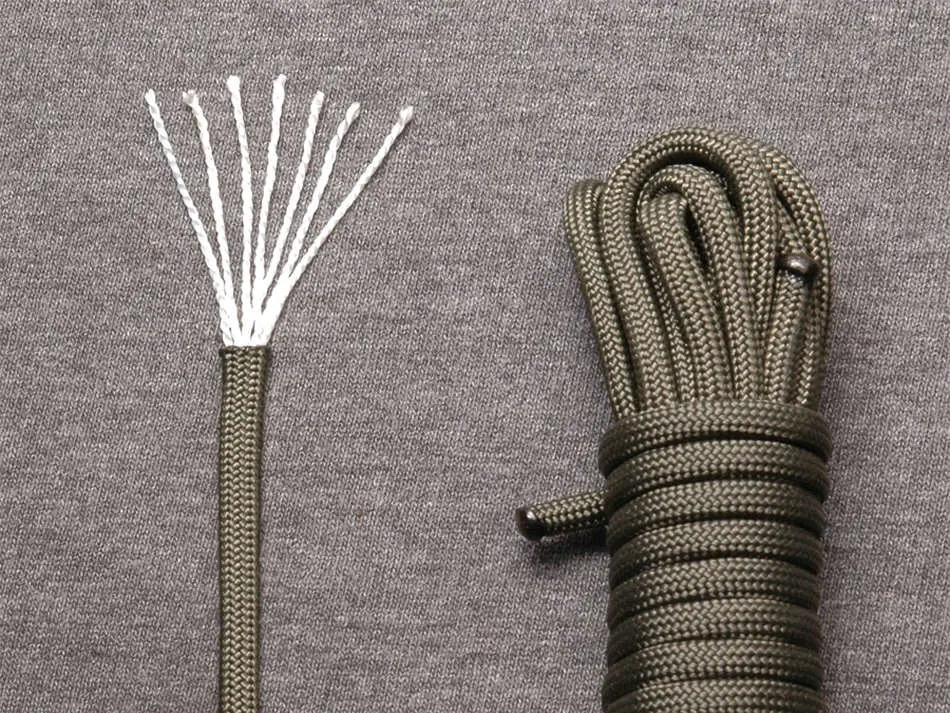
What Can You Use a Paracord for?
I know you asked about the uses of a paracord during survival situations, but let’s first see and understand the different application of the paracord.
- Survival situations: The paracord is a must-have item during outdoors activities, such as hiking, camping and climbing. During hiking, the paracord is used to tie different items and tools to the backpack. It also replaces shoelaces that get torn and can be used to build a shelter. You can also remove the inner strands if you wish to create impromptu survival tools. These can be traps, fishing lures, fishing line, slings and sutures.
- Crafting purposes: The paracord can be used to make different items, like bracelets, belts, jewellery, a carrier for a water bottle, keychain, and more. Some even go the long distance and make steering wheel covers, chairs, hammocks and sculptures using the paracord.
- Fashion purposes: The paracords today come in different colors and strengths, making them very popular in the fashion industry, specifically as bracelets.
How to Use the Paracord in Survival and Emergency Situations
Start a Fire
If you’re lost and want to signal your location, or if it’s getting cold and you need fire and warmth to keep you alert and alive, you can use the paracord to start a fire. There’s a special paracord that allows you to start a fire easily and it is the Firecord.
By melting the cut ends of the paracord, you expose flammable material. It doesn’t matter if your paracord is made of polyester or nylon, it will burn if it’s hot enough. Some paracords come with an additional red strip in the core, which is flammable. So, you can take off the red strand from a cut piece of cordage and produce a flammable tinder. Additionally, you can take out the red strand from a cut portion of the paracord. Then, use an open flame to set the strand on fire and utilize it like a tinder. Use it to light another firestarter, such as dry leaves or twigs.
Keep Away Bears
When camping or hiking, it is best to have a place to rest like a tent or some kind of a shelter. If the area is populated with wild animals and especially bears, the paracord can be used to keep them away.
An important rule is to keep the food away from the shelter, so in case wild animals smell the food, they won’t encounter you face to face. Usually, the food is being hanged from a tree that grows a bit further away from the shelter. The paracord is then used to tie the food on the tree and thus keep the animals away from you and your camp.
Here is how to safely hang your food:
- Take about 100 ft. of paracord and sling it over a sturdy branch with a rock tied to one end.
- Detach the rock.
- Slide the paracord along the branch till it’s 5 ft. or more from the tree.
- Take your food sack, tie to one end of the cord and hoist the sack up, about 5 ft. under the branch and 12 ft. above the ground.
- Tie the paracord’s other end to another tree, and you’re set.
Your food cache will be safe throughout the night.
Build a Shelter
If you find yourself in a situation where you are forced to sleep and spend the night out in the wild, the paracord can be used to build a shelter. In such a case, find some branches of trees and gather approximately 10 large and sturdy branches. Then, remove the seven inner core strands and with simply tie some knots to bring and secure all branches together.
You can also utilize the paracord to construct a basic hammock. If you have some tarp with eyelets along its perimeter, just thread the paracord though them and hang the hammock by tying it to two nearby trees.
Use it as a Ladder
If the terrain is too steep, difficult to climb, you need to get up on a tree or find yourself at the bottom of a ravine, the paracord can also be used as a ladder made of ropes. Take the two parallel cords and make a ladder made of rope to climb and ascend wherever you require. Don’t worry about it tearing or breaking. It can support up to 550 lbs., remember?
Use it as a Rescue Line
The paracord can be used as a rescue line as well. If in any case someone needs to be helped out of a quicksand, fell down a ravine or drowning, use the paracord as a rescue line and pull the person back to safety. You can tie a figure eight knot with the paracord, toss it to the person who needs to be rescued and help him out.
I will cover some of the basic and most important survival knots to know later in this article.
Use it to Carry and Transport Big and Heavy Stuff
The paracord is strong and sturdy, so you can tie things you need and carry them, even if those items weight a lot. Whether you need to haul and carry big branches, prey, firewood and other heavy stuff, the paracord can help you in this mission without the fear of it tearing or breaking.
Use it to Catch Fish
In case you’re stuck in the wild, but near a lake, sea or stream with fish, you can use the paracord to catch them for food and survival. You can use the paracord as a trotline and leave it to catch fish while you’re taking care of other missions at hand. Alternatively, make a lure and cast the paracord like a standard fishing line. Finally, you can take the yarns out of the paracord and improvise a fishing net.
If you wish to make a fishing net from your paracord, here is how you do it:
- Cut the paracord in the desired net’s length. I recommend 5-15 feet, this should be enough.
- Next, separate the inner strands from the outer sheath. The outer sheath should be placed horizontally while the inner threads should be placed vertically.
- Then, attach them to the corners, where both the sheath and the inner threads meet. The inner strands must be tied to the sheath in 2 inches intervals, on both sides.
- Repeat the process in the opposite direction. Make a quick knot wherever you overlap a strand.
Make a Trap
The paracord can be used to catch other animals for food in survival situations. Find a good spot, build a snare and use the paracord as a trigger for your trap.
Knowing how to make a snare is a veru useful survival skill, so here is a video guide on a basic snare:
Use it as a Tourniquet
If you get badly injured and there is no way to get to the hospital, you can use the paracord as a tourniquet. What you should do is tie the paracord above the wound so it will apply pressure, and thus slow the blood loss from your body until you get medical help.
Use it to Make a Splint
In case of an emergency suffering a broken bone, use the paracord to make a splint. You should place a stick on top or near the broken bone, and then fasten it using the paracord in order to immobilize the bone. It will also prevent more potential damage.
Cut Through Zip Ties
If you find yourself in a situation where you’re bound with zip ties, the paracord can assist you getting free as you can use the laces and use it as a saw. When you work the paracord aggressively across a zip tie, you actually make the plastic of the zip tie weaker and eventually it will break.
The way to do it is to remove the laces, tie them together, and then make a long and single cord. Then, make a large loop on each end that fits your feet. The next step is to thread the paracord through the zip tie. Each foot should be placed in one of the loops. Make a peddling motion with your feet, moving them back and forth. This will turn the paracord into a makeshift saw, heating up the zip tie’s plastic. The plastic will melt, freeing you.
Make a Bow
A bow and arrow can be of use during survival situations, whenever you must hunt animals for food or has a need for self-defense. With paracord, you can make your own archery gear. You will need a few feathers and tree shoots to make arrows, a sharp knife and a flexible sapling. You should find a stick for the bow, preferably a dead and dry one. Also select a material for the arrow shifts, such as a tree sucker or shoots.
- To fletch the arrows, take a portion of a paracord and remove a few strands.
- Make arrow shafts by cutting the shoots to the length you feel comfortable with. Make a nock in each arrow and add feathers.
- Tie a string to the bow, check its bending, remove the string and carve the inner side of the bow until the limbs are of the same length.
- Once you’re done, release one end of the string. Twist the cord so that it becomes tighter and less elastic. Tie it back while it’s tend.
Your bow is now ready. Happy hunting!
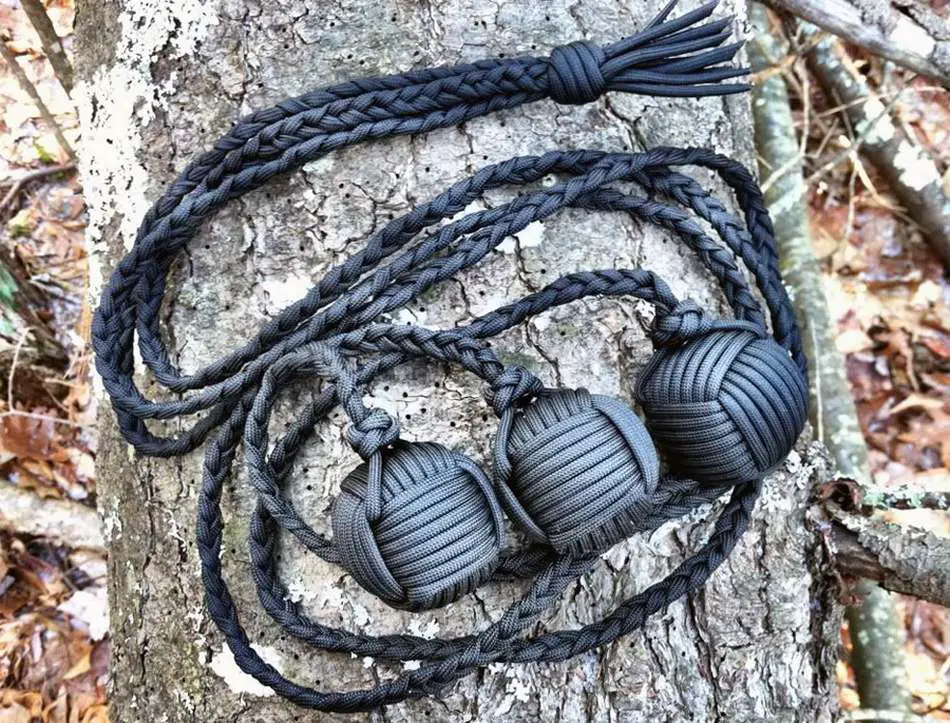
Make a Bola
A bola is used as a weapon, so in this case it’s best to use it for self-defense as well in survival situations. You can also use the bola to haunt large birds. Here is how you make a bola:
- Use an overhand knot or a figure eight knot and join together 3-5 cords. Each section of the cord needs to be between two and three feet long.
- Then, find some stones to add weight, best each stone to be approximately 6-8 ounces. If you can find round stones, use them, as they will probably not cut through the covering.
- Next, you should wrap the stones in wet rawhide or leather, then in the edges of the rawhide make a few holes and fasten each and every cord to weight. Remember that the rawhide should be completely dry for it to harden and shrink, and this way hold the stones better.
- Now, it’s time to use the bola. Use your dominant hand to hold the cord-joining knot. Focus on the target, whip the weights in the air above your head and throw on the target.
You now have a survival weapon that will take care of your protection and will feed you when you’re in the woods.
Make a Stretcher
If you happen to be sick, extremely dehydrated, suffer from broken bones or any other reason that keeps you from progressing on foot, the paracord can be used to make a makeshift stretcher.
It’s not recommended to leave someone injured in the wild, even to get help. Chances of his injuries getting worse increase, he may be attacked by wild animals, suffer from dehydration or hypothermia. So, when you have a paracord with you, just make a stretcher and leave no man behind.
Here is how you make a stretcher:
- Find the middle of the paracord and then measure approximately 5 lengths in each direction, which will give you a total of 10 lengths. In this part, the injured person will lie.
- Use a clove hitch to make a loop by tying each length with the extra piece of paracord.
- Now you need to thread the remaining part of the paracord through the loop, and then tie the stretcher’s body with the end.
- If possible, you can add stability by using poles rather than the paracord. The poles should be the same length as the stretcher.
- If you don’t have poles, simply weave the paracord through loops.
- To make the stretcher stronger, you can use the cord 2 or 3 times more or make it into a braid.
The following video demonstrates a similar method of making a stretcher:
Use it to Make Snow Shoes
Weather can be unpredictable at times and hiking in deep snow without the proper gear is almost impossible. Each step you take will get you deeper into the snow and you’ll be wasting tons of energy as well, which can ultimately risk your life.
The paracord can help you make your shows similar to snow shoes, allowing you to progress more easily in the snow. Here is how to do it:
- Find four branches that are at least 4 inches longer than your foot and also ten branches that are 4 inches wider than your foot.
- Next, place all four long branches to be parallel to each other on each side of your foot, as this will be the outer framework.
- Now, step out of these branches and place five small branches to connect each of the long parallel branches. The small branches should connect the top, the top half, the center, the bottom half and the bottom.
- Tie the crossing branches using constrictor knots. Use a crisscross pattern as you weave the paracord on these foundations for snow shoes.
- Finally, make loops at the top to firmly hold the shoes on your feet.
You are now ready for the snow. You can also make snow shoes with paracord using fewer sticks, as demonstrated in the following image. You will need two sticks for each shoe, and a lot of paracord. Choose whatever method suits you best.
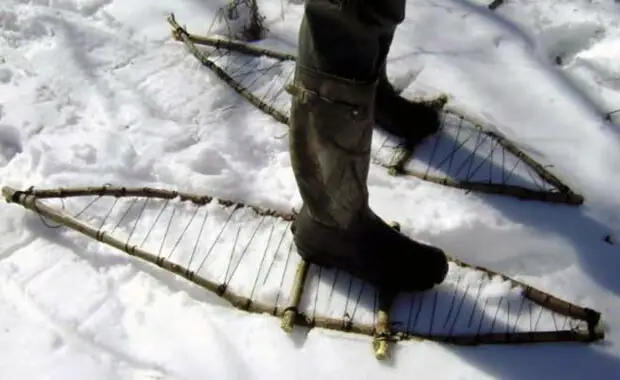
Use it as Trail Markers
Even if you’re an experienced hiker or traveler and have a great sense of direction, it’s still fairly easy to get lost in the wild, especially if weather conditions are harsh and there are no markers around to pin-point your location. Luckily, the paracord can be used as trail markers as well.
Tie small strips of the paracord to trees or branches so you can see them, as this will assist you finding your way back to camp and basically retrace your steps safely. You can also use these small strips of your paracord for tinder if you wish to start a fire or for zipper pulls.
Use it to Make a Raft
I’ve written an article about how to survive on a deserted island, so if you have a paracord with you, you can use it to make a raft. If for any reason you need to cross a stream of water that is high and there’s no way to cross it by foot or swim (if the current is extremely strong), a raft can be the answer in these situations.
In order to make a raft, just find a couple of logs and using some survival knots with the paracord, your raft is ready to go (or rather, float).
- To build the raft, get five logs made of wood. It’s recommended that they will be one foot in diameter.
- Then, get four branches which are thick and strong to secure all the logs together. Make sure that the width of the branches is 8 inches longer than the logs.
- Next, place the logs next to each other, measure a foot from the logs’ bottom and top and use two branches to sandwich the logs.
- To make your raft even stronger, you can use the cord 2 or 3 times more or make it into a braid.
Repair Clothes that Got Torn
Clothes can get torn, especially in nature and the wild, and it’s fine. You can fall, slide, hit a branch of tree or face any other given situation in the wild, which can cause torn clothes. With the use of the paracord, you can fix and repair the clothing.
If you need to sew a tear in your clothing, simply take out the thread from the paracord’s center. Thread through a needle and make stitches to repair the torn fabric.
Use it to Replace Broken Shoelaces
You can’t walk barefoot or without proper shoes in the wild as you risk wounds and injuries which will slow you down, or worse. If you have a broken shoelace and need to replace it, simply remove it and measure it to the length of the paracord. Then, you should melt the ends so it won’t fray. Now, you can place the paracord instead and use it as a new shoelace.
Paracord Knots You Ought to Know
Knowing how to knot with the paracord will help you achieve your goals much faster, in the safest and easiest way. So, the following video (courtesy of The Weavers of Eternity Paracord Tutorials) demonstrates the knots you must know how to make with your paracord, especially in survival situations.
The Most Recommended Paracords
Now you know what a paracord is and all of its uses, especially outdoors, in the wild, and for survival and emergency situations. At this point, I would like to recommend 3 of the best paracords you can own.
Survival Frog’s 550 lb 9 Stands /w Fishing Line and Fire Cord
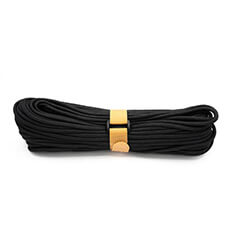
This paracord is known for its incredible versatility. Its cords can be used for a wide variety of tasks, such as sewing, fishing, tying, making a shelter, and much more. As a bonus, you also get a fire tinder cord that helps you start a fire in seconds. The fire tinder cord is painted red and cannot be confused with other cords. The 550 paracord is extremely strong, and you can full rely on it to keep things together.
Click here to read more reviews and compare prices.
BENGKU Outdoor Mil-SPEC 550lb Paracord
A type 3 paracord for multipurpose use. The braided sheath of the paracord is made of 32 interwoven strands and the core features 7 yarns. Each of these yarns is made of 3 small fibers that are twisted. Material is made of nylon, making it elastic and of course as you already know, can hold up to 550 lbs.
Click here to read more reviews and compare prices.
TOUGH-GRID 750lb Paracord
Also made in the USA, this paracord is made of 100% nylon and features 11 inner triple strands, instead of the regular 7 strands. It’s very strong, durable and meets the specifications of US military as well. Breaking point is 750 lbs., and it comes in various lengths, from 50 to 1,000 feet.
Click here to read more reviews and compare prices.
Survival Bracelet
Now I would like to talk about the survival bracelet. A survival bracelet is also known as a 550 cord bracelet (since it is made of a paracord that can support weight of up to 550 lbs) or parachute cord. There are 7 strands in the cord, and every strand has 3 additional strands inside of it. All in all, this creates an impressive number of cord you can use. Basically, it is a paracord that you can wear as a bracelet and use it immediately or store in the backpack. However, it is more than just a paracord, since it’s a survival bracelet.
What exactly does this mean? A survival bracelet features other useful tools apart from the paracord. Not all bracelets feature the same tools, but the common ones you can find in a survival bracelets are: paracord, knife blade, whistle for emergencies, compass, fire-steel and striking blade and LED light.
The survival bracelet is used by survivalists, hikers, campers, climbers, and whoever engages in outdoor activities. The bracelet is known to be a survival tool. It can be extremely helpful during emergencies and survival situations, and even save life. Here’s an example: in a case of an injury, puncture or wound, you might start to bleed. With the bracelet on your hand, you’ll be able to instantly use it in order to strip the cord for a tourniquet.
The Uses of the Survival Bracelet
Because the survival bracelet contains the paracord as well, you’ll be able to use it for all the purposes I’ve mentioned earlier in the article. However, since it comes with other useful tools, the survival bracelet allows you use it for other survival purposes as well, especially when an emergency strikes.
- Knife blade – The knife can serve you for self-defence, or cut and carve things. You can even use it to open cans, just be careful when opening. Not all survival bracelets feature the knife. Some may come with a hawkbill knife, which is good for self-defence, while others may come with a double-edge straight blade, which functions as a cross-utility tool.
- Compass – When in the wilderness, everything looks the same and there may not be any cell phone reception or signal. A compass is the tool that will help you find your way out.
- Emergency whistle – In case of an emergency, such as an injury that prevents you from advancing forward, use the emergency whistle to reveal your location. The whistle will save you, especially when you can’t use the cell phone. Simply blow three loud and short blasts on your survival whistle, with each blow lasting approximately three seconds.
- Fire-steel and striking blade – Make fire outdoors and in the wilderness to keep warm, cook, boil or scare away various animals, predators and insects.
- LED light – If you don’t have a flashlight at hand, you can use the LED light that comes with the survival bracelet to find your way when it’s dark.
- Paracord – Use the paracord as mentioned earlier in this article.
How to Choose a Survival Bracelet?
When choosing a survival bracelet, there are some factors you may want to consider. I will go over them right now:
- Functionality – Ask yourself why you need the bracelet for and how you will be using it. Let’s say you’re looking for the complete package, then choose a bracelet that features a compass, knife and everything that can come in handy during survival situations. If you don’t need everything with the bracelet, you can choose a lighter mode. So basically, choose according to your needs.
- Quality – It’s important to choose a bracelet that features high-quality materials. The paracord in the bracelet should support weight of 330 lbs. to 550 lbs. Also, there are paracords that stretch for longer distances and look visually better, in case the design is something that’s important to you.
- Weight – The weight of the bracelets will vary according to the tools they feature. If survival is your main goal, it’s best to choose a lightweight design of the bracelet, so you won’t use too much energy operating or carrying it, and it won’t weight you down.
- Clip design – The clip is important during survival situations, as the bracelet acts as a drag-handle, so your friends can pull you out to safety in case it comes to this. On the other hand, if you’re just going for a hike or camping outdoors, and there will probably be no pulling, then consider choosing a lightweight bracelet that comes with a plastic clip.
- Price – The price of the bracelet will vary according to the tools it features, its functionality and the manufacturer. Cheap bracelets may cost around $6 while premium bracelets will cost around $30. Again, choose your bracelet according to your needs, but also according to your budget.
- Color – Some bracelets may come with different colors, while others have only one color. It’s not a crucial factor if you ask me, just choose a bracelet you’ll enjoy wearing.
Best Survival Bracelets
Now that you know a thing or two about the survival bracelets, I would like to recommend three of the best survival bracelets you can get today:
Paracord Survival Bracelet by Frog & CO
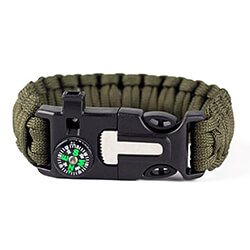 This paracord bracelet ensures full survival in the wilderness. It comes with hooks, line, and sinkers, which can be used to catch yourself a fish for a dinner. It also includes a tinder and Firestarter, so that you can cook your fish over the fire and stay warm in the evenings. The compass will guide you to safety, while the included whistle can be used to call for help. And finally, the 10 feet of high tension 550 paracord can help you build a shelter and tie everything together.
This paracord bracelet ensures full survival in the wilderness. It comes with hooks, line, and sinkers, which can be used to catch yourself a fish for a dinner. It also includes a tinder and Firestarter, so that you can cook your fish over the fire and stay warm in the evenings. The compass will guide you to safety, while the included whistle can be used to call for help. And finally, the 10 feet of high tension 550 paracord can help you build a shelter and tie everything together.
Click here to read more reviews and compare prices.
Nexfinity One Survival Paracord Bracelet
The bracelet features a 550 paracord (7 strands in the cord) that can be adjusted, its waterproof and has 10 feet of tactical paracord. This bracelet also contains a fire starter, SOS LED light, compass, and even a compact multi-tool that has a blade, screwdriver, saw, wrench, scrapper, and more. The bracelet weighs only 0.18 pounds.
Click here to read more reviews and compare prices.
X-Plore Gear Emergency Paracord Bracelets (set of 2)
Compact paracord bracelet that comes with additional survival features: a compass, an emergency whistle, and a fire starter. It’s waterproof and highly durable. With thousands of positive reviews on Amazon, this paracord bracelet if the one you can rely on.
Click here to read more reviews and compare prices.
Final Words
And there you have it, the many uses of the paracord, a must-have item in your hiking backpack or emergency kit.
Of course, know how to use a paracord is just one of many required survival skills. You should acquire such skills as starting fire without matches or purifying natural water. Feel free to browse through my blog, there are tons of useful information just for you.
Stay safe out there!

